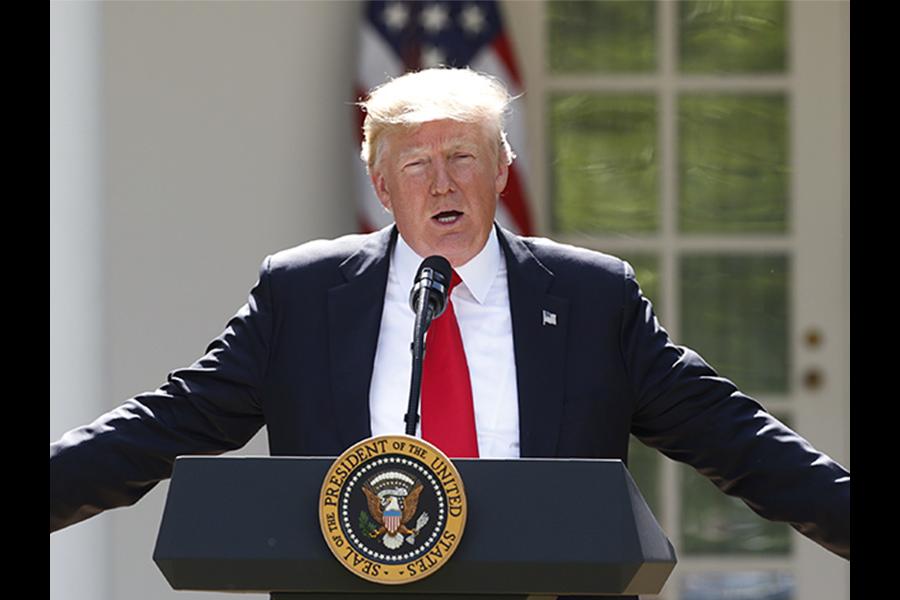Reaching the world's climate goal - with or without Trump
Donald Trump's rash decision to pull the United States out of the Paris Agreement creates the opportunity for India to lead the world in climate reduction
Donald Trump’s decision to pull the United States out of the Paris Climate Agreement on Thursday, despite last minute pressure from groups across the US to remain part of the 195-country deal, sent ripples of discontent across the world. The US is now one of three countries in the world, along with Syria and Nicaragua, to not be part of the agreement. While devastating to climate activists and to the spirit of international cooperation in general, this move doesn’t have to stop the rest of the world—including India—from moving forward on climate goals.
Negotiated over several tense weeks in 2015 and signed by President Obama, the agreement was one of the most significant international environmental pacts ever penned. Its goal is to keep the earth’s average temperature from warming more than 2 degrees above its pre-industrial mark—the threshold beyond which climate scientists say sea level rise and other effects would be catastrophic. To this end, the agreement included long-term greenhouse gas emissions target contributions for each country.
It also reiterates commitments to adaptation—strategies for dealing with the challenges of a warmer climate and rising sea levels, and efforts to finance a green economy. While non-binding under international law, it represented concerted effort on behalf of nearly all the world’s leaders to tackle climate change.
Trump promised to leave the Paris Climate agreement while on the campaign trail, though it was unclear if he’d actually pull the plug. Long a skeptic of climate change—calling it a “hoax” propagated by the Chinese to suppress US manufacturing—this is the latest, and perhaps most significant, action taken by Trump under his “America First” doctrine, calling the agreement unfair to American workers and the economic impacts of “draconian”.
Trump is stuck on China and India in particular. “India will be allowed to double its coal production, we’re expected to half ours”, he said at the White House on Thursday. Never mind that natural gas and other cheaper energy sources have killed US coal production, not international climate agreements.
Trump also failed to acknowledge that India’s per capita carbon emissions are a mere fraction of the US’s, or nearly 300 million people in India still live without reliable access to electricity, while misstating that India’s participation in the accords was contingent on receiving “billions and billions and billions” of dollars in aid. It’s not.
The process of removing the US from the agreement will take three years, and under Trump’s energy policies, the US was already on track to vastly exceed their Paris pledge, having already rolled back the Clean Power Plan, the Obama administration’s key regulatory method of cutting carbon emissions. The US has already paid $1 billion into the Green Climate Fund—a mechanism of the Paris agreement to funnel green financing from developed to developing countries—but will stop short the US’s $3 billion pledge.
While Trump has said that he remains open to reentering the agreement “on terms that are fair to the United States, its businesses, its workers, its people, its taxpayers”, other countries have expressed unwillingness to renegotiate a deal that took weeks of tense debates to come about.
Trump’s rash decision creates the opportunity for India to lead the world in climate reduction. PM Modi announced that India will keep its Paris commitments—whether or not the US is involved, but he has stopped short of signaling that India will fill the gap in leadership on climate issues or make up for the extra emissions to now be emitted by the US. China now has the opportunity to fill this role as well.
To be sure, Trump’s decision is calamitous to the international effort to tackle climate change, and its reverberations have yet to be fully seen. But much of the financing and technology sharing that flows between the US and India isn’t part of the Paris accords, but is laid out in bilateral agreements between the two countries. These agreements are still in place, though they may be up for discussion during Modi’s visit to the White House later this month.
More than ever, Trump’s disregard for the future of the planet is a call to other countries—as well private business—to do more to fill the gap created by the US’s Paris exit. Heads of business and capital have already stated their dissatisfaction with Trump’s decision. India has the chance to make the most of it.
The thoughts and opinions shared here are of the author.
Check out our end of season subscription discounts with a Moneycontrol pro subscription absolutely free. Use code EOSO2021. Click here for details.

